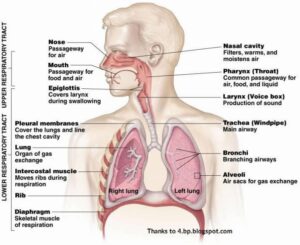What are the benefits of prāṇāyāma?
The benefits of prāṇāyāma (prāṇa = motility or breath + ayama = stretching/ restraint) originate from the fact that it converts our breathing from a reflex action into a conscious action. This gives us the ability to manage our reaction to stimuli. As a result, we can control our stress levels which results in better health and well-being, as well as balance the creative and analytical aspects of our intellect. To reap the benefits of prāṇāyāma, all it takes is a simple, conscious, and focused breathing practice – the yogic breathing practice.
The benefits of prāṇāyāma – Increased awareness throughout the mind and body

The movement of breath is kinaesthetic.
Our breath is traceable, as it moves in and out of the body. One can enhance this awareness by following the course of breath at various points – such as the nostril, nasal cavity, tongue, throat, chest, stomach, pubis, or anus.
Thus, one achieves increased awareness and control over the breath(prāṇāyāma). Also, this focus activates the relevant cakras and results in improved functioning of the organs in that area.
Types of respiration in prāṇāyāma
- Normal breathing –This breathing is a reflex action, which we do not consciously notice. It is calm when we are at rest.
- Stressed breathing –When we are stressed or emotionally disturbed, Breathing is erratic, shallow, and rapid.
- Rapid breathing –This is a type of conditioned breathing. This can be done in 2 ways, (1) short breaths confined to the lungs (2) deeper inhalation and exhalation with use of the abdomen. In both, there is increased aspiration capacity and greater use of dead lung spaces.
- Deep breathing – There are two types of deep breathing – reflex and conscious. Reflex breathing occurs in situations of complete peace. Conscious deep breathing is nāḍī-śuddhi-prāṇāyāma.
- Breath-holding – In stressful situations, we often hold our breath as a reflex action. In prāṇāyāma, holding the breath is deliberate and is a part of the breathing practice for increased awareness.
Where do we focus during prāṇāyāma – The movement of breath
When we focus on the movement of breath throughout our body, we begin to derive the benefits of prāṇāyāma breathing.
During the practice of prāṇāyāma, we focus on the movement of the breath in the following areas:
- Nostril – The focus is on awareness of incoming and outgoing breath at the tip of the nostril.
- Roof of the nasal cavity – The olfactory bulb at the roof of the nasal cavity is closest to the amygdala, pineal, pituitary, hypothalamus glands, and brain stem. Awareness of the breath at this place helps in the management of stress.
- Throat – Awareness of breath as it moves past the throat which has the thyroid, parathyroid, pharynx, and larynx helps control fear and the endocrine organs.
- Thoracic – The thoracic cavity encloses the heart, lungs, trachea, and diaphragm, all enclosed in the rib cage. Awareness (prajñā) should be on the breath moving at the sternum.
- Abdominal – The abdominal cavity holds multiple organs associated with digestion, reproduction, and waste disposal. All of these organs are enclosed in the peritoneum, which is itself enclosed within the abdominal wall. Both the peritoneum and abdominal wall are exerted during breathing.
The benefits of prāṇāyāma derived from thoracic breathing
- It increases the volumetric efficiency of the lungs.
- As the heart pumps de-oxygenated blood to the lungs, brings back blood pregnant with oxygen, and then pumps it to the rest of the body, this area increases oxygen content in the blood.
- This reduces stress and regulates blood pressure.
- The diaphragm acts like bellows, pulling in oxygenated air and throwing out exhausted air.
- Also, the increased oxygen reduces the number of destructive free radicals, thereby increasing tissue health.
The benefits of prāṇāyāma derived from abdominal breathing
- During complete inhalation, the abdomen moves downwards until the maximum deflection of the diaphragm. This increases the volumetric efficiency of the lungs.
- The practice of prāṇāyāma acts as a massage of the abdominal organs with each other. Consequently, the blood supply to all digestive organs improves. This results in the regeneration of all digestive organ tissue, improved peristalsis and evacuation, improved endocrine functioning, and better absorption of nutrients. This increases the activity of samāna-vāyu and the movement of prāṇa through the maṇipūra-cakra.
- Awareness of the breath at the periphery of the bottom of the abdomen enhances the activity of prāṇa through the mūl̄adhāra and svādhiṣṭhāna-chakra.
Relationship between prāṇāyāma and the abdominal cakras
All the abdominal organs are placed in a loose structure within the peritoneum. So, prāṇāyāma impacts the health of the abdominal organs significantly. The significant points of the peritoneum impacted are:
A – The peritoneum is anchored at the bottom of the abdomen, between the anus and genitals. This is the rectovaginal excavation. This is the location of the mūl̄adhāra-cakra.
B – Also, the peritoneum is anchored behind the pubis. This is called the uterovesical excavation. This is also the location of the svādhiṣṭhāna-cakra.
C- The peritoneum flexes most at the centre of the abdomen or navel. This location is the maṇipūra-cakra.
What are the hygiene requirements in prāṇāyāma practice?
To derive the benefits of prāṇāyāma, it is important to practice it in the following manner:
- It should be performed in a clean room where there is minimum dust. Practicing in the open is best.
- It is ideal to do the prāṇāyāma breathing after āsana. One should rest for some time after āsana. Blood is redirected from the musculoskeletal system to pulmonary circulation (circulation between heart and lungs) during āsana. The rest time after āsana will enable stabilize the blood supply before prāṇāyāma practice.
- Before beginning prāṇāyāma, cleanse the nose of physical blockages.
- Perform prāṇāyāma on an empty stomach, preferably at least 4 hours after a meal. This will enable the intestines to fully absorb the food. A full stomach will act as an impediment to the free movement of the diaphragm and abdomen. In extreme cases, this could result in cramps. Eating on an empty stomach permits free movement of the diaphragm and the abdomen.
- The benefits of prāṇāyāma will be maximized if it is performed in the morning time. The night cools the air, resulting in a higher density of air close to the surface of the earth. The oxygen content in the air is higher in the morning, due to lower pollution and higher density of air. This will increase the oxygen content absorbed by the body during prāṇāyāma.
Listen to the advice of one of India’s oldest yoga institutes on prāṇāyāma.
Points to ponder on prāṇāyāma
Internal Links: Dharma (conditioning), Stress and Situational Awareness, Prana, Asana overview 1, Asana Overview 2, Asana Focus or gazing, Hatha Yoga Pradeepika
External Links: Prana, Chakra, Pancha Tattva, Pancha Prana, Pancha Kosha, Nadi, respiration
- Watch your breath at the nostril, throat, chest, and abdomen. What do you experience?
- What happens to your breathing when you are anxious?
- How do you breathe when you are in love?
- What happens to your breathing when you go for your annual appraisal?


